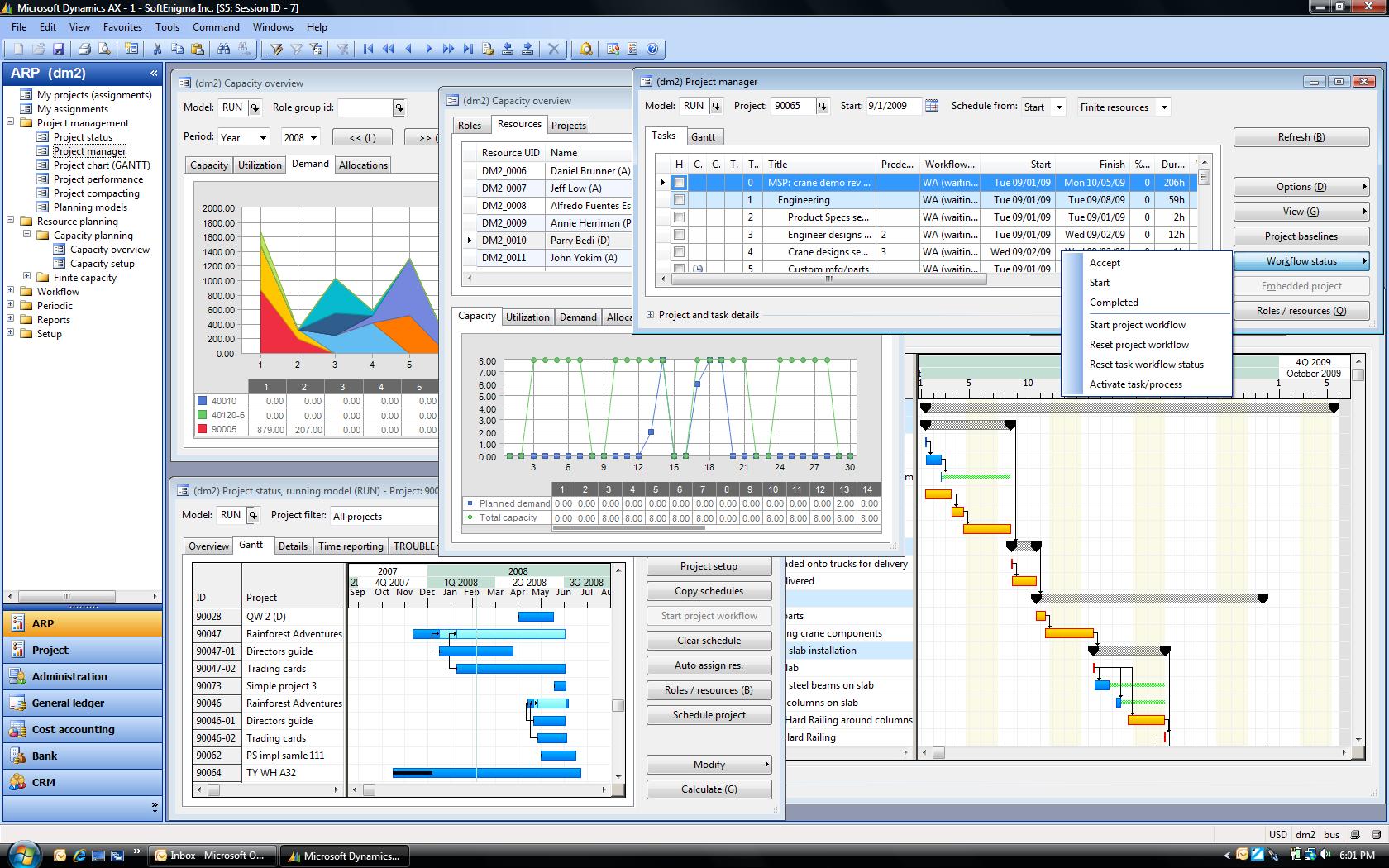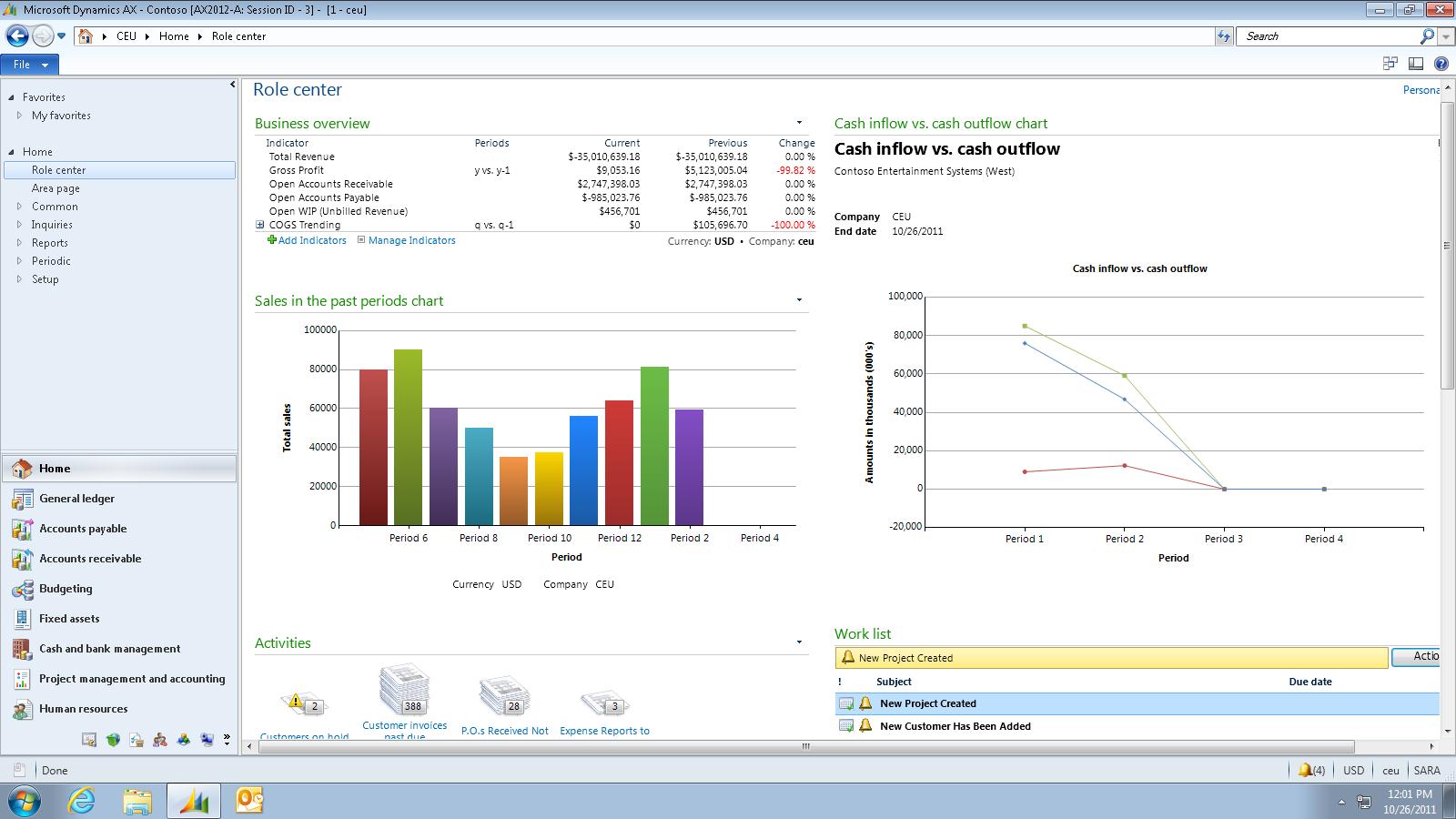Microsoft Dynamics AX
Microsoft Dynamics AX (formerly Axapta) is an object-oriented ERP system. It is used especially in medium-sized and larger companies.
History
Axapta was originally developed by Damgaard. Then the merged company Damgaard and Navision and called themselves since Navision Damgaard. Since 2002, the new Navision Damgaard Microsoft bought for $ 1.4 billion, the Axapta ERP solution now belongs to the range of Microsoft Business Solutions. As part of a rebranding of Microsoft ERP products that should be transferred within the framework of the so-called Project Green in a unified Microsoft ERP system, Axapta is marketed to the complete replacement by the new product under the name of Microsoft Dynamics AX. The version of Axapta 3.0 was replaced by the Microsoft Dynamics AX 4.0 version in July 2006. Among many additions to the functionality of the client has been revised and the surface of MS Office 2003 applies. At first glance, are not so visible the profound changes in the system architecture ( increased focus on security (Trusted Computing), only a three-layer architecture), the development environment ( inter alia integration. NET ) and the underlying product philosophy (away from the integrating software towards an integrated part of a so-called Microsoft stack). The version AX 2009, in 2008 the first highly visible proof of this philosophy dar. Since the end of 2011 is the latest version of Dynamics AX 2012 on the market, the role-based surface was even more adapted to the surface of the Office product line. The web interface (Enterprise Portal ) was also adjusted via SharePoint 2010, Office environment.
OS base
From the beginning of the Axapta server ran only on Windows 2000 and Windows 2003 - at least that is true for production systems. In development or test area can be used for version 3.0 and Windows 2000 or XP Professional. Since version 4.0, the use of Windows Server (2003 or 2008 ) is mandatory. Reasons for this is also that user authentication via Active Directory is made. The associated Axapta client runs on all Windows systems.
Axapta provides with the Enterprise Portal Server using the IIS and - version 4.0 - SharePoint Portal Services also connect through Internet Explorer.
Database Support
As underlying databases either a Microsoft SQL Server or Oracle system are used. For an Oracle connection, the utilization statistics and data throughput evaluation are not available, but can be determined using the Oracle Enterprise Manager. The support of Oracle databases is set with the 2012 version, however.
Software Development
The ERP system can be customized and extended X by the Axapta programming language. The X is a mixture of the Java programming language, BASIC, C , and SQL. The tables, objects and methods are for the most part open source and can be adjusted. Through a layer structure, a customized by the customer object anyway be released. There are a total of 16 layers, which belong together logically two layers. The first four layers (SYS, SYP, GLS, GLP ) are reserved for Microsoft. The fifth and sixth Layer ( DIS, DIP) is used for the delivery of country-specific functionalities. For this there is a layer version for several countries. The seventh and eighth layer (LOS, LOP) contains local functions that relate exclusively to the Anfordernisse a country. In the ninth and tenth layer (BUS, BUP ) certified solutions, for example, delivered by partners. The eleventh and twelfth (VAR, VAP) layer is used consultants to deliver adaptations and extensions for your customers. Layer 13 to 16 ( CUS, CUP, USR, USP) are reserved for the customer. Layer to " P" ends, are generally used for the delivery of updates and service packs for the underlying layer. If, for example, for a service pack changes in the SYS layer necessary, these will be delivered in the SYP layer. The Layer rely on each other, that is a change of an object in a higher layer hides the object in the underlying.
Except for USR / USP, the layers are protected by passwords, so that they are read-only.
In version 4.0, the previous layer SYS, GLS and DIS were combined into a common SYS - Layer, country-specific functionalities are installed in a GLS layer. The LOS -layer was (at least for the time being ) deleted without replacement. In addition, Microsoft Visual SourceSafe has been integrated, allowing for versioning of the source code.
In Version 2012 the layer structure was revised ( SYS / SYP, GLS / GLP, FPK / FPP, SLN / SLP, ISV / ISP, VAR / VAP, CUS / CUP, USR / USP ) and extended by this model. Models are collections of application objects within a layer, which are suitable for partner solutions and an industry modules, in order to integrate better and with less effort to migrate to an existing installation.
Industry Solutions
Often the functionality of Dynamics AX, extended by the partners, in the form of industry solutions. One hand, this functional gaps of the standard are fully or partially closed, on the other hand by the change is much more difficult to another Microsoft partner. The current version AX 2012 has been extended by the purchase of selected partner solutions with features such as lean production ( kanban ) and retail (POS ) significantly in the standard.
System adjustments
System adjustments can be made in Dynamics AX partly by customizing. However, it is also common practice to modify a standard system ( modify ). The system behavior is affected by changes in the source code. This makes the layer technology valuable services, since only the top modified layer is performed. Often, only the cost of your current adjustment is used to assess a modification. However, this is incorrect because a modification even with any future update of the component leads to renewed effort. However, when a lower layer (for example, country-specific updates for versions) replaced and updated, those updates are covered by the modification.
Updates
Updates for Dynamics AX standard system are delivered directly from Microsoft via the distributor. Since almost all Dynamics AX - installations have some extensive modifications of the source code, the update can not be installed easily. Rather must be checked for each code change in the source code, even if modifications trigger the desired effect. Therefore, update projects are not trivial and can have a in extreme cases, to achieve comparable high development costs with a new introduction. This is especially true if the additional programming was carried out not clean by the partner. Partly also provide Microsoft Partner Updates for your industry solutions. Again, any code customization and modification to check again.
Documentation
Axapta X and the logics are not sufficiently documented in version 3. However, one can be incorporated into the Axaptafunktionen quickly through the layer structure and the open source code.
The built-in Development Guide provides an overview of syntax and selected constructs the actual business logic is largely undocumented. This will change in the current version of Microsoft Dynamics AX 4.0 fundamentally; is planned including a comprehensive documentation of the basic classes, which will also be available on MSDN. However, Microsoft seems not to have held nearly a year after the release of 4.0, this promise.
There are numerous books on the market to Dynamics AX. As German literature, for example, "Basic Guide to Microsoft Dynamics AX " by Andreas Luszcak is recommended. From Microsoft there are current version of training materials in English and German (MOC ).
Training is offered as for other Microsoft products as well as a series of MOC courses of so-called CPLS ( Certified Partners for Learning Solutions ). These training courses that deal with the different modules of the software and allow certification at various levels, are offered throughout Germany by partners (current information can be learned about the appropriate Microsoft country representative ). In order to ensure a thorough training are thorough knowledge of programming language X inevitable, which are also offered in various training courses.
Distribution system
Axapta can not be bought directly from Microsoft. Instead, it is driven by external consultants who carry out the implementation as well as any necessary adjustments. Also support and training are provided or mediated by partners. These consultants must have obtained various certificates Axapta and thus demonstrate that they possess the necessary expertise.










